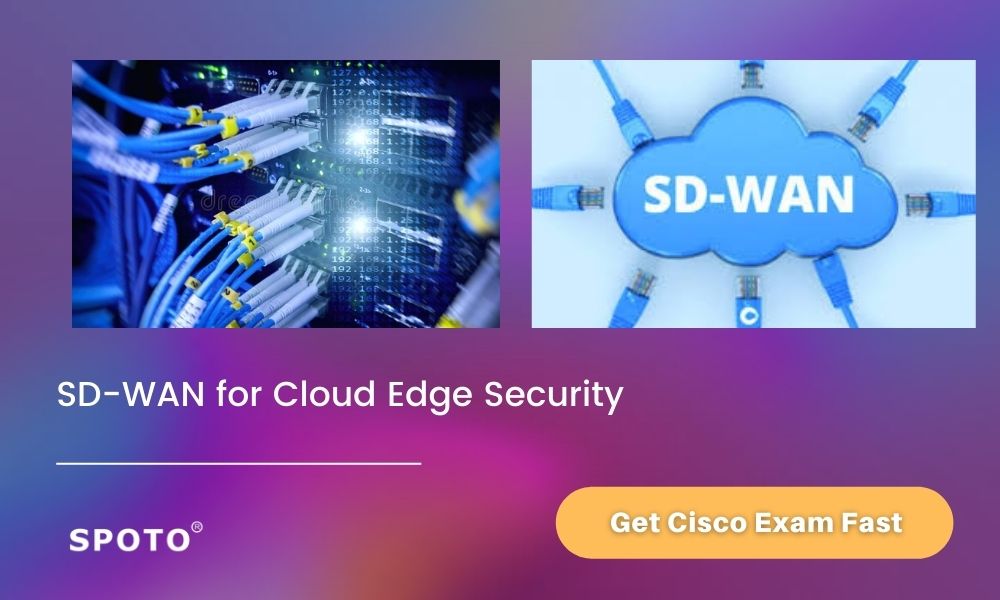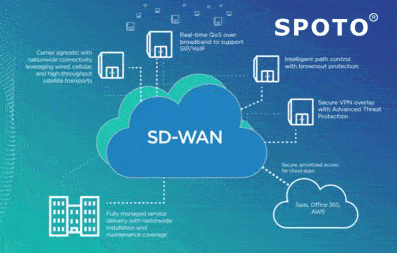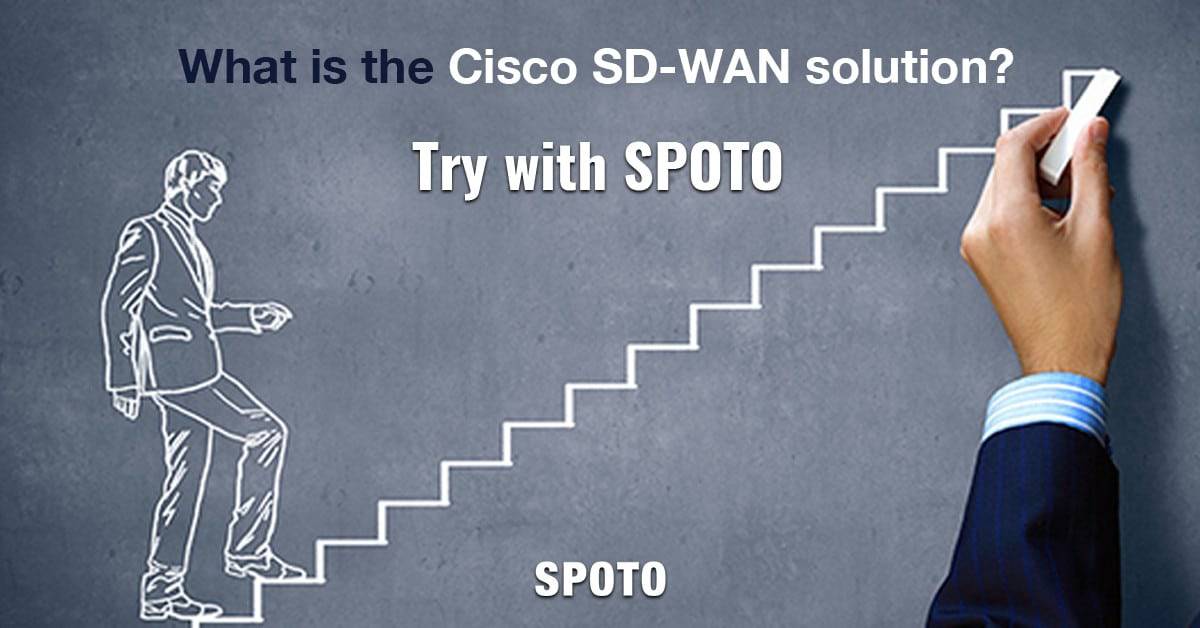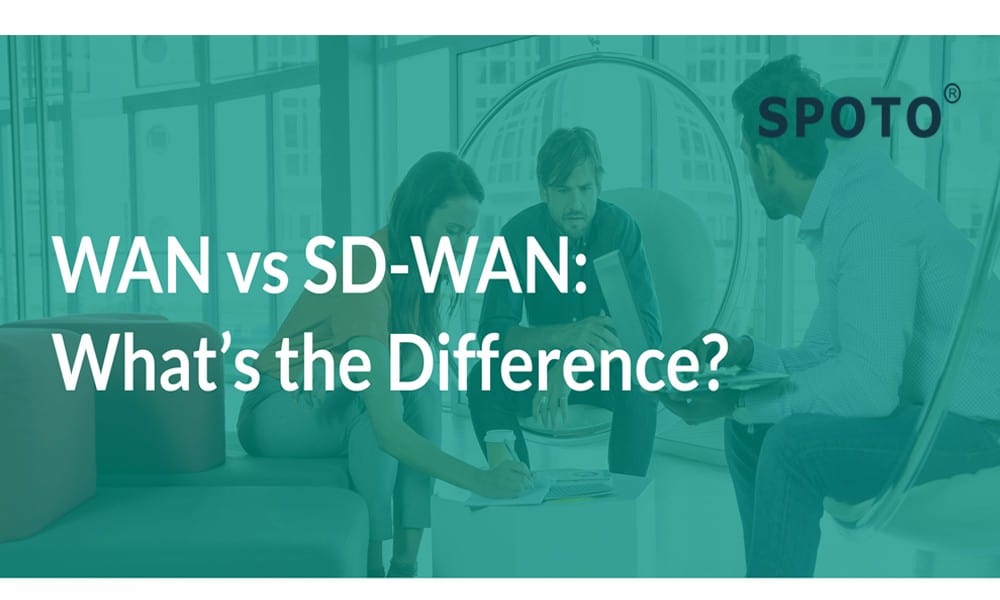-
- Cisco SD-WAN
- SPOTO Club
- 2024-01-18
Cisco SD-WAN technology is already improving networks by linking branches, colocation, data centers, and cloud resources into the information fabric that connects a distributed company. However, organizations face increased security concerns, unpredictable application performance, and increasing complexity at the Cloud Edge—the confluence of the network, cloud, and security.
As branches open up to direct cloud connections and operate mission-critical apps over the internet, the old method to WAN security, which involves routing traffic back to the corporate firewall, is inefficient and costly. This is because old WAN solutions were built primarily to connect branches directly to data centers. They lack the flexibility to handle many cloud platform connections simultaneously, automatically selecting the most efficient and cost-effective ways.
Organizations require a complete and adaptable software-defined architecture to secure the WAN while simplifying distributed network management and minimizing connection costs. Every WAN device must, in effect, become software-defined and protected. As a result, we introduce a new comprehensive SD-WAN security stack that addresses critical edge security challenges. Cisco offers highly effective and scalable security for SD-WAN that is simple to manage, deploy, and maintain, allowing businesses to employ cloud services confidently. Cisco SD-WAN connects devices and people to any cloud seamlessly, enabling a superior application experience while delivering consistent unified threat prevention from branch to cloud.
Every WAN device must become software-defined and safe as applications migrate from data centers to numerous cloud platforms.
SD-WAN is important in the Cisco exam, if you want to know more about SD-WAN knowledge, please try SPOTO Cisco exam dumps to learn the latest technology!
Cisco SD-WAN Offers Four Levels of Edge Security
The typical approach to cloud edge security is to route all traffic back to the corporate data center for inspection, analysis, and filtering before forwarding it to SaaS apps or public cloud services. This option typically necessitates the deployment of pricey MPLS lines for distributed companies, which increases the scale and complexity of data center security layers. The more traffic there is among scattered branches, the more expensive and complicated it is to manage multiple MPLS connections and data center security.
The all-new Cisco SD-WAN security stack offers a comprehensive shield that operates at the edge, in the branch router, with centralized control for network and security management. The inherent security features protect data traveling to and from branch business systems and cloud platforms. The security stack also covers the entire connected company against crippling security assaults resulting from compromised internet connections and applications. The Cisco SD-WAN security stack focuses on four critical traffic profiles that are particularly important in the branch:
Compliance: Ensuring the security of sensitive data at rest and in transit, in the branch and the cloud.
Direct Internet Access: Allowing direct internet connections through network ports significantly widens the possible attack surface from external sources.
Direct Cloud Access: Allowing direct access to cloud resources and SaaS applications circumvents the company network's and data center's current centralized security (DMZ, Firewalls, Intrusion Detection).
Guest Access: Allowing guests to connect to local Wi-Fi from personal devices while keeping corporate traffic and sensitive network functions separately.
Let's look at how the security improvements we're delivering reduce the threat surface exposed by these traffic profiles while leveraging the cost reductions afforded by our SD-WAN architecture.
Compliance
Every company accepts, maintains, and processes sensitive data sets such as personally identifiable information (PII) and payment card information (PCI). Application-aware firewalls ensure that only authorized applications and users have access to sensitive data. Cisco SD-WAN security includes an embedded application-aware firewall in the branch router that learns and enforces which applications are permitted to access sensitive data types such as PCI. The SD-WAN fabric then delivers sensitive traffic to apps in the business data center or multi-cloud platforms over a secure VPN. In Cisco Intent-based Networks, intents such as "transmit sensitive data type PCI only on the IPsec VPN" can be programmed once in Cisco vManage and automatically deployed throughout the network, with Cisco vSmart Controllers dynamically segmenting traffic based on security regulations.
Access to the Internet Immediately
Before introducing SD-WAN, enterprises depended primarily on secure but costly MPLS connections to connect branches to the data center, where security services would be housed. Organizations breach the traditional centralized security barrier by allowing applications and devices at branch sites to access the internet directly. As a result, the branch is exposed to all forms of internet traffic, increasing the attack surface at the edge.
To combat these risks, the SD-WAN Security stack includes a set of embedded security capabilities such as an application-aware firewall, intrusion detection and prevention, and a cloud security layer based on Cisco Umbrella DNS. According to SecOps policies, the Cisco SD-WAN fabric automatically sends traffic to and from branches. Web security keeps a local cache of secure URLs continuously updated to reflect the most recent security danger information.
Direct Access to the Cloud
Direct cloud access enhances application QoE for cloud and SaaS apps while presenting a risk profile comparable to Direct Internet Access. Cisco SD-WAN Security employs a DNS security layer in conjunction with intrusion detection to prevent the most aggressive Denial of Service, phishing, malware, and ransomware threats that can exploit internet connections and open ports utilized by SaaS and cloud services. Furthermore, these embedded security capabilities make use of the most recent threat data from the Cisco Talos team, one of the world's most powerful commercial threat-intelligence teams.
Access for Guests
Retail businesses, for example, are eager to open up their branch Wi-Fi to customers to provide interactive methods of engaging them. Allowing guests to use the branch's Wi-Fi, on the other hand, exposes them to corporate apps, data, and services. The first step is to implement a security policy that restricts guest access, such that although internet access is permitted, all other aspects of the company network are not. Organizations must continue to prevent guests from downloading malware that could infect the branch network, either accidentally or purposefully. Cisco SD-WAN Security includes web filtering, intrusion detection, and prevention features to help prevent internet infections from spreading throughout the network. Furthermore, segmentation prevents employees from accessing the guest network, with all business data passing through IPsec VPN tunnels.
SD-WAN Makes Security Management Easier
Cisco SD-WAN offers a GUI-based workflow via the cloud-managed vManage controller to enable the new security stack capabilities and simplify management. The absence of contact Cisco ISR/ASR and vEdge routers can be powered up in the branch by non-technical staff and remotely configured based on pre-defined business intents tailored to the business's needs. Edge routers continuously monitor traffic patterns and alter connections automatically to accommodate priority business data, maintain cloud and SaaS application QoE, and proactively respond to security risks.
These advancements in our Cisco SD-WAN portfolio aid in the resolution of real-world security concerns confronting organizations today. Even better, SD-WAN comes with our DNA Essentials license, making licensing a breeze. You can expect further advancements from our technical team to help link and secure branch offices with corporate, multi-cloud, and SaaS application platforms, all while improving performance and lowering the total cost of connectivity.
For additional information on Cisco SD-WAN features, you can check on the SPOTO blog. And if you want to grasp the updated and trended technological points, please try the SPOTO Cisco training course and Cisco exam dumps to help you get the Cisco certification on the first try!
-
- Cisco SD-WAN
- SPOTO Club
- 2024-01-18
SD-WAN, the acronym for the Software-defined wide-area networking, and AIOps are both considered to be the red-hot technologies. SD-WANs would be increasing application availability, reducing costs as well as in some cases, improve performance. AIOps would be infusing machine learning into IT operations to increase the level of automation. This would be reducing the errors and would be enabling businesses to make changes at digital speeds. Most think of these as separate technologies, but the two would be on a collision course and might give rise to what they call the AI-WAN. For having more details regarding the SD-WAN, you could go for the training courses offered at the SPOTO Club.
CCIE Enterprise Infrastructure Course Outline:
SD-Access Elementary Course
SD-WAN Elementary Course
SD-Access Advanced Course
SD-WAN Advanced Course
Automation and Programmability
Get now! Contact us for more latest SD-WAN technology and limited offer!
AI-WAN might transform network operations
So how would be the evolution of SD-WAN into AI-WAN by changing network management as well as operations? Administrators could be able to utilize their time to focus on strategic initiatives instead of fixing problems. Another data point from ZK Research would be that 90% of the time could be taken for fixing up a question that is spent identifying the source. Now that applications would be residing in the cloud and running on mobile devices, identifying the cause of a problem would get even harder. AI-WANs would have the ability to spot even the smallest anomaly, even if it hasn't yet begun to impact the business.
Security is considered to be another concern. Everything from mobile devices to IoT (Internet of Things) to cloud computing would be creating multiple new entry points as well as shifting resources to the network edge. This would be putting businesses at a security risk, as they would be struggling to respond to changes quickly.
Businesses could be missing security gaps, which would be created by users, with hundreds of SaaS (software-as-a-service) apps being utilized at the same time without IT's knowledge. Older networking technologies couldn't support SaaS as well as cloud services, while SD-WANs could. But merely deploying an SD-WAN isn't going to be enough for protecting a network.
Increasingly, vendors would be bundling AI-based analytics with SD-WAN solutions for boosting their network security. Such solutions utilize AI to analyze how certain events would impact the network, application performance, and security. They would then be creating intelligent recommendations for any network changes, like an unauthorized utilization of SaaS apps.
AI-WAN would be existing today and would be exploding in the future.
AI-WAN might seem to be futuristic, but there would be several vendors that would be delivering it or in the process of bringing solutions to the market. Managed service provider Masergy, for instance, recently would be introducing AIOps for SD-WAN for providing autonomous networking and has the most completing offering.
Open Systems, another managed service provider, would be snapped up cloud-based Sqooba for adding AIOps to its robust network as well as security services. Keeping with the M & A theme, VMware would have recently acquired AIOps vendor Nyansa and rolled it into its VeloCloud SD-WAN group. That move would be giving the VMware similar capabilities for Aruba Networks, which would be initially applied AI to WiFi troubleshooting but would be now bringing it to its SD-Branch offering.
Cisco would be another networking vendor with an AIOps story, although it's trying to apply it network-wide, not just with the WAN. Over time, they would be expecting every SD-WAN or SASE vendor to bring AIOps into the fold, changing the focus away from connectivity to automated operations.
If you are learning for the Cisco Certification, you might be able to gain more knowledge with the training course, which you could obtain through the SPOTO Club. We offer 100% real and valid Cisco CCNA, CCNP, and CCIE Lab exam practice tests to help you obtain the dream Cisco certification in the single attempt!
-
- Cisco SD-WAN
- SPOTO Club
- 2024-01-17
SD-WANs are considered to be a new form of corporate connectivity, which would be designed for adapting to modern IT practices as well as the connections to the cloud. In the past, corporations that would be building their own WANs utilizing proprietary hardware as well as service-provider network connections amongst the data centers, but that would be all changing. Applications are considered to be moving to the cloud and Internet broadband costs would be declining, paving the way to creating virtual WANs that would be tied together for leveraging Internet broadband utilizing software and COTS hardware (commodity off-the-shelf).
Before we check out some of the components of Cisco SD-WAN, if you would be looking for more knowledge, you could check out the training courses which would be offered by the SPOTO Club.
SD-WAN for Router Replacement
Technology professionals would like to talk about “use cases” for emerging technology. These would be useful reference points for why the technology would be purchased or implemented, though they aren’t the be-all or end-all. The SD-WAN market would be containing many use cases as well as features that would be appealing to the different enterprises as well as service providers. Many of the SD-WAN vendors and managed service providers would be focusing on specific niches. For that reason, we would have to try to highlight some of the specific requirements as well as features being sought by specific customers.
One of the more popular functions of SD-WAN is considered to be the router replacement or router consolidation. One of the higher costs of WAN frequently cited by enterprise customers is considered to be the operating expense (OPEX) of managing proprietary hardware as well as CPE (customer premises equipment), which would be including branch-office routers. Additionally, hiring certified specialists for managing these branch-office routers is quite expensive.
SD-WAN Security Functions
Another allure of SD-WAN technology is that it could be utilized for deploying security functions like the VPN (virtual private network) as a software overlay utilizing end-to-end encryption. This would be able to help you to meet security requirements for businesses that might wish to connect branch offices or retail outlets but would be also having high-security requirements.
SD-WANs, because they would be virtual networks controlled from the cloud, also have the suppleness to plug in additional security functions without specialized hardware. Value-added security services like the stronger encryption as well as IDS (intrusion detection services) could be offered by the SD-WAN providers. This could be a matter for debating, as some SD-WAN providers would believe some security services, like the UTM (unified threat management), would be required to be distributed to the cloud, due to the necessary compute power. There would be a wide variety of approaches in how security functions would be running in SD-WAN, whether they would be hosting on an appliance or in the cloud.
Why does SD-WAN Will continue to Grow?
You might now gain the picture; there would be many functions as well as utilizes cases for SD-WAN technology that could be delivering a direct ROI (return on investment). Whether an enterprise would be looking for reducing the cost of opex by replacing proprietary routers, saving network costs by replacing or augmenting MPLS, and just move to a more modern platform that would be yielding more flexibility, it is clear that SD-WAN is considered to be one of the hottest markets in technology. It would be also driven by incumbent network players like the Cisco as well as VMware to make big-ticket acquisitions for getting ahead of the curve.
For having more details about the Cisco SD-WAN Components, you should check out the training courses which are being offered at the SPOTO Club, if you wish to achieve success in a single attempt.
-
- Cisco SD-WAN
- SPOTO Club
- 2024-01-17
Cisco SD-WAN solution is designed to provide a highly secure cloud-based open architecture that is programmable and scalable at the same time. It can be managed through a Graphic User Interface called Cisco vManage console. Using the Cisco vManage console, the IT professionals can connect data centers, branch, and regional offices. This Cisco SD-WAN solution provides efficiency in network speed along with security because it is centrally managed.
Cisco being the pioneer in the networking IT industry has widely deployed Cisco SD-WAN solutions worldwide. This system has been deployed to as many as all the fortune 2000 businesses, and it is growing day by day. These fortune 2000 enterprises include healthcare, retail, energy, manufacturing, oil & gas, logistics, etc.
The Cisco SD-WAN solution has solved many critical problems in the IT industry related to these fortune 2000 enterprises. This has reduced the overall costs. The enterprises can get better-centralized controls of managing and analyzing across the WAN. It is also helpful in deploying the complete security solution to co-location, branches, regional office at lower costs with no compromise in data security.
Following are the security feature of the Cisco SD-Wan solution:
• Enterprise Firewalls
• Secure Web Gateway
• DNS layer security & URL filtering
• Built-in Intrusion prevention system
• Cloud Access Security Broker (CASB)
• Malware protection
The Cisco SD-WAN solution supports multitenancy because multiple users can be created, and a separate VPN can be assigned to each user. In short, the Cisco SD-WAN solution comes up with many features that can be counted to reduce the costs and improve the enterprise network's security. Cisco provides fully integrated communication support for its SD-WAN solution. Cisco offers certification courses that come up for different domains and different entry-level. For example, they have the necessary entry-level qualification for the newly joined IT networking associates, and they have medium and expert level qualifications.
The basic level qualification for IT networking associates is CCNA, which is the basic entry-level. CCNP is for the IT networking professional, and it is a medium level certification. CCIE is the highest expert level qualification, which is also respected and highly paid certification worldwide. The CCIE expert can design, plan, implement, troubleshoot, and secure any given network.
CCIE exam consists of two parts: the written and the second is lab; however, passing this exam is difficult. The individual has to give both of the two parts to get CCIE certification. CCIE experts are also able to demonstrate and deploy the Cisco SD-WAN solution. Here are a few voice and application optimization features which are supported by the Cisco SD-WAN solution;
• Cisco SD-WAN supports FEC and packet duplication for voice optimization.
• Cisco SD-WAN supports TCP optimization for internet optimization.
• Cisco SD-WAN supports SLA dynamic routing based on real-time network telemetry for on-premises applications.
• Cisco SD-WAN also supports dynamic routing based on cloud and telemetry for SaaS applications.
In conclusion, Cisco SD-WAN users can find it a predictable application that can be used to increase the user's productivity by optimizing the cloud or their on-premises application with real-time results. However, making a career in the IT networking industry requires a lot of practice, as mentioned above, because Cisco certifications are the only way to demonstrate your skills on Cisco SD-WAN solution an employer can trust.
With Cisco exam dumps and solving SPOTO cisco practice tests can lead to earning Cisco's certification bypassing their exam even in the first attempt.
Recommend exam study materials:
Is SD-WAN better than MPLS?
What is the difference between WAN and SD-WAN?
The coming together of SD-WAN and AIOps
Cisco SD-WAN Components You Should Know
What is the command-line interface utilized on a Cisco router?
Which would be the best training institute for CCNP Enterprise certification?
How many exams are there for CCNP Enterprise Certification?
-
- Cisco SD-WAN
- SPOTO Club
- 2024-01-16
Would you be facing issues with your current network infrastructure? Do you have a cloud migration strategy? If you haven't considered the benefits of a software-defined WAN solution, SD-WAN now might be regarded as the time. Because it would be delivering through the cloud, SD-WAN would be reducing capital expenditures and simplifying network operations. Before we look into both of them, check out the SPOTO Club's IT exam training courses.
Traditional WAN solutions would often be incorporating a hybrid of public as well as leased lines. MPLS, which is considered a traditional WAN connectivity method, is utilized to assign preference, which would be based on SLA guarantees. You could be determining timeliness for delivery of traffic. This would be become very important, particularly for voice as well as video-based applications. Additionally, traditional WAN would be leveraging internet-based backup as a secondary transport should the primary path be unavailable. While traditional WAN could work well for some businesses, there would be disadvantages to remaining traditional WAN architecture.
What are the disadvantages of traditional WAN architecture?
Failover, switching to a standby server or system when your primary application would be going down, would be utterly dependent upon the state of the link (up/down). This means that you are required to depend on routing protocol re-convergence. This could cause several seconds worth of outage, resulting in dropped or phone calls or lost video.
The configuration would be distributed, meaning that configuration is housed locally on each router, but would typically template.
New policies are required to be managed on a per-device basis and need your administrator to touch each device as policies change.
A significant time is required for new site turn-up. This would be including time for equipment provisioning, circuit delivery, as well as change management. New sites could take months to turn up due to the complexities of change management and project coordination.
Why SD-WAN?
SD-WAN is considered to be a shift in the way a Wide Area Network would be managed and deployed. As its name implies, SD-WAN is deemed to be a software-driven technology with application awareness that would be managed from a centralized point in the network. SD-WAN solutions would be deployed as an overlaying technology to an existing topology, which would allow for ease of integration and adoption over time.
The advantages of SD-WAN include:
Lower circuit costs:
SD-WAN technology would be allowing for the elimination of costly MPLS circuits. It makes utilization of lower-cost, higher-speed options for connectivity like broadband or DSL. Of course, MPLS circuits could still be utilized based on circuit availability, additional SLA requirements, as well as ease of integration.
Adoption of cloud-based services:
With traditional architecture traffic, routing typically back to the data centers, with a requirement of constant filtering in place. This results in sub-optimal routing and potential latency for cloud hosting providers such as Office 365. SD-WAN would be moving us toward local internet offloading and gaining user traffic closer to cloud services.
SD-WAN would be providing simplified QoS as well as prioritization of critical applications across the WAN. Rather than waiting for an up/down event, SD-WAN would be providing real-time traffic monitoring for diverting business-critical traffic across the brownout events.
Ability to support high-bandwidth intensive applications concurrently, offloading them on local internet wherever applicable. These bandwidth requirements could be a challenge for traditional WAN.
For a more detailed overview, check out the SPOTO Club's training courses to achieve success in the first attempt.
Recommend exam study materials:
What Are the Features of SDN?
What are the advantages of SDN?
Cisco NFV and SDN: What’s the Difference?
Are SDNs withdrawing the Value of the Cisco CCIE or CCNP?
What is the change in Cisco 2020?
What Are the Values and Reasons to Obtain Cisco Certification?




